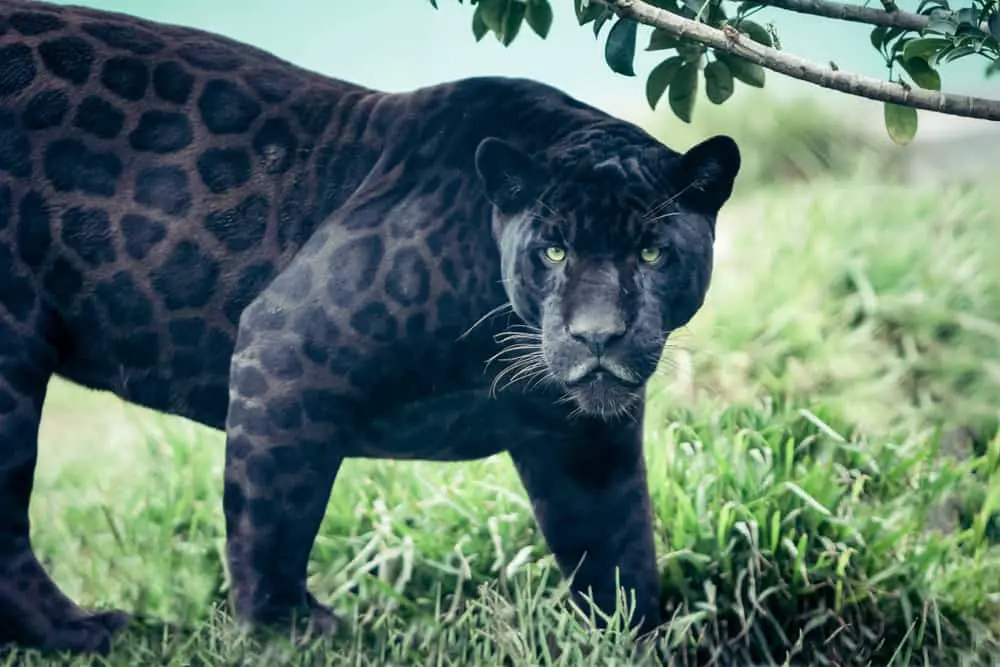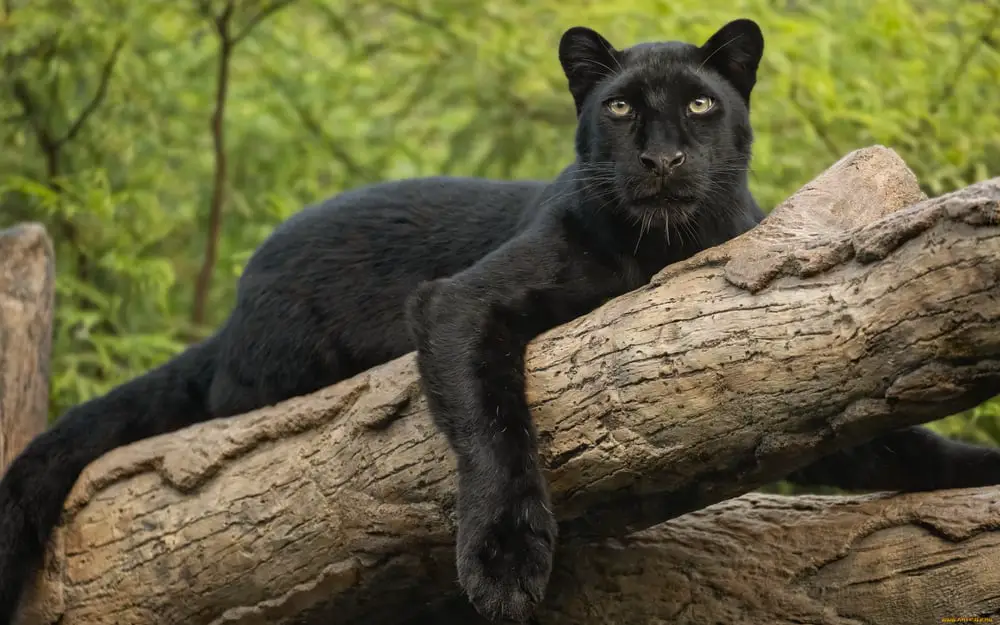Panthers are large carnivorous mammal that belongs to the Felidae family. The name is used to describe any black animal of the big cat family Felidae.
They are big cats native to Africa and Asia, with their population being distributed across various regions including sub-Saharan Africa, India, Southeast Asia, and China.
Panthers have been admired by humans for centuries due to their majestic appearance and ferocious nature. The panther has a distinctive physical appearance which makes it easy to identify among other big cats.
The body of this feline is muscular and stocky in build with short legs relative to its size. They have a unique fur pattern consisting of black spots or rosettes on a tawny background coat color.
However, not all individuals display these markings as some may be completely melanistic (black) without any visible patterns.
They also possess sharp retractable claws used for hunting prey along with powerful jaws capable of crushing bones.
Panthers are apex predators within their habitat and play an important ecological role in maintaining natural balance through regulating prey populations.

The Panther’s Habitat And Distribution
The panther, also known as the black leopard or jaguar, is a large carnivorous feline that inhabits various regions across the globe. Its geographical range spans from Asia to Africa and South America. Specifically in Asia, it can be found in India and parts of Southeast Asia. Meanwhile, in Africa, its habitat ranges from Ethiopia down to South Africa. In South America, it thrives throughout much of Central and Northern regions.
Due to their wide distribution across different continents, panthers have adapted to varying habitats present in these areas. For instance, they are able to thrive in tropical rainforests where there is dense vegetation cover by using their keen senses such as sharp vision and hearing abilities. Moreover, they can climb trees quickly and stealthily which makes them especially adept at hunting prey that live among treetops like monkeys.
Panthers are also great swimmers thanks to their muscular bodies and broad paws which help them navigate waterways with ease when pursuing aquatic animals for food. Overall, these adaptations make panthers highly versatile predators capable of living in diverse ecosystems around the world.
Physical Characteristics Of The Panther
The panther is a large and powerful feline with distinct physical characteristics. Its coat is typically black, although some individuals may have a slight variation in coloration due to genetics or environmental factors. This dark coloring provides the panther with excellent camouflage in its natural habitat of dense forests and jungles. Additionally, the panther has keen senses, including sharp vision, acute hearing, and an exceptional sense of smell that allows it to successfully hunt prey.
Adaptation techniques have played a significant role in the evolutionary history of the panther. These animals have developed various strategies for survival over time, such as their ability to climb trees quickly and quietly to escape potential predators or stalk unsuspecting prey from above. Furthermore, they possess incredible strength and agility that enables them to take down larger animals like deer or wild boar when necessary. The combination of these adaptation techniques makes them one of nature’s most formidable hunters, ensuring their place at the top of the food chain for generations to come.
Despite being solitary creatures by nature, Panthers are incredibly protective parents who will do whatever it takes to ensure the safety of their cubs.
Their piercing yellow eyes give them an intimidating appearance that strikes fear into smaller animals while simultaneously mesmerizing humans.
Unfortunately, human activities like deforestation and hunting pose a severe threat to Panther populations worldwide, highlighting the importance of conservation efforts aimed at preserving this magnificent species.
Overall, learning about the physical characteristics and evolutionary history of the panther can help us appreciate just how remarkable these creatures truly are. From their unique adaptations for survival to their awe-inspiring beauty, there is no doubt that they hold a special place in our hearts and minds.
The Panther’s Fur Pattern
Panthers are known for their striking physical characteristics, including their muscular build and sharp claws. However, another notable feature is the fur pattern that adorns their coat. Panthers have a distinct black or dark brown coloration with unique spots scattered across their entire body. These spots can range in size from small dots to large splotches depending on the subspecies of panther.
One interesting aspect of the panther’s fur pattern is its color variation due to genetic mutations. Some rare variations include all-black melanistic panthers, which appear completely black without any visible spots, and leucistic panthers, which lack pigmentation in some areas of the coat resulting in white patches. The cause of these genetic mutations remains unclear but they add to the mystique surrounding this elusive predator.
Overall, while the traditional black or dark brown spotted panther is most commonly recognized, there are several fascinating color variations among different subspecies as a result of genetic mutations. These unique traits make each individual panther even more remarkable and captivating to observe in their natural habitat.
The Circle of the Panther: Exploring the Mysteries of Its Lifecycle
Hunting And Feeding Habits
The panther is a powerful predator that uses various hunting techniques to capture its prey. It relies on stealth, speed, and agility to hunt down animals such as deer, wild boars, rabbits, and birds. Panthers are known for their ability to stalk their prey silently through the undergrowth before pouncing with lightning-fast reflexes. They also use their exceptional vision to spot potential targets from afar.
Prey selection is an essential aspect of panther feeding habits. Panthers tend to focus on smaller or weaker individuals within a herd rather than taking on larger and stronger prey. This strategy reduces the chances of injury while maximizing the chances of success in capturing food.
Once they have successfully captured their prey, panthers will drag it away into cover where they can eat without being disturbed by other predators or scavengers.
The ruthless efficiency with which panthers hunt evokes both fear and admiration among animal-lovers. Their impressive physical abilities make them one of nature’s most awe-inspiring hunters.
However, some may feel sympathy for the hapless creatures that fall victim to these mighty beasts.
Regardless of personal feelings towards this magnificent creature’s predatory instincts, there is no denying the sheer power and gracefulness displayed during a successful hunt.
Ecological Importance Of Panthers
The ecological importance of panthers extends beyond their charismatic appearance. They play a significant role in regulating the population of prey species, which helps maintain a balance within ecosystems. Panthers are apex predators that primarily feed on white-tailed deer, but they also consume other mammals such as raccoons and armadillos. Their hunting behavior is critical for controlling the population of these animals, preventing overgrazing, and preserving vegetation.
Moreover, panthers’ presence in an ecosystem affects more than just the populations of their prey species. As top-level carnivores, they can influence the entire food web by altering the behaviors and distribution of other animals.
For example, when panther numbers decline or disappear from an area due to habitat loss or poaching, it creates a cascading effect throughout the ecosystem. Without panthers preying on herbivores like deer, those herbivores may become too abundant and start damaging plants at higher rates than usual.
This damages plant communities and limits resources for smaller organisms that depend on them as habitats or food sources. Therefore, protecting panther populations is essential not only for their survival but also for maintaining healthy ecosystems with diverse wildlife populations.
| Prey Species | Population Regulation | Ecosystem Impact |
|---|---|---|
| White-tailed Deer | Control Overgrazing & Preserve Vegetation | Influence Behaviors & Distribution of Other Animals |
| Raccoons | Prevents Overpopulation | Affects Food Web |
| Armadillos | Maintains Balance | Limits Resources |
Panther’s play a crucial role in regulating prey populations by controlling the numbers of deer, wild boar, and other prey species, thus preventing overgrazing and maintaining a healthy balance in the ecosystem. They also influence ecosystem dynamics by shaping the behavior and distribution of other animals, such as coyotes and raccoons, and by helping to preserve vegetation through their hunting and foraging activities. |
Threats To Panther Populations And Conservation Efforts
Human encroachment and habitat fragmentation remain the primary threats to panther populations in many areas. As human populations continue to expand, they often come into conflict with wildlife, leading to a loss of suitable habitat for these animals.
Panthers require large territories to roam freely and hunt their prey, but as more land is developed or converted for agriculture, their habitats are increasingly fragmented. The effects of habitat fragmentation can be devastating on panthers and other wildlife species.
It reduces genetic diversity, limits access to food sources, and increases competition between individuals for resources. Additionally, it makes them more vulnerable to predation by other animals and exposes them to diseases that may not have been present before.
Despite conservation efforts aimed at protecting panther populations from further declines due to human activities such as hunting and poaching, much work still needs to be done towards mitigating the negative impacts of human encroachment and habitat fragmentation so that future generations can enjoy seeing these magnificent creatures thrive in their natural habitats.

Conclusion
The panther is a magnificent creature that roams forests and swamps in the Americas. These solitary animals are elusive and can be difficult to spot in their natural habitat. They are found primarily in southern Florida but have been seen as far north as Georgia and Alabama.
Panthers have powerful legs that allow them to leap up to 20 feet horizontally or 15 feet vertically. Their fur ranges from reddish-brown to gray, with white underbellies. The black-tipped ears and tail distinguish them from other large cats like jaguars and leopards.
Panthers play an essential role in maintaining ecological balance by controlling the population of prey species such as deer. Despite being protected under the Endangered Species Act, panthers face many threats to their survival, including habitat loss due to human development, collisions with vehicles on roads through their territory, and illegal hunting.
Conservation efforts include captive breeding programs and wildlife corridors designed to connect fragmented habitats for these majestic creatures. In conclusion, the panther’s beauty and grace capture our imagination while serving a crucial function within its ecosystem. However, without concerted conservation efforts, this iconic species could disappear forever.
We must all work together to preserve this symbol of wildness for future generations so that they too may witness the awe-inspiring sight of a panther roaming freely through our wilderness areas.

